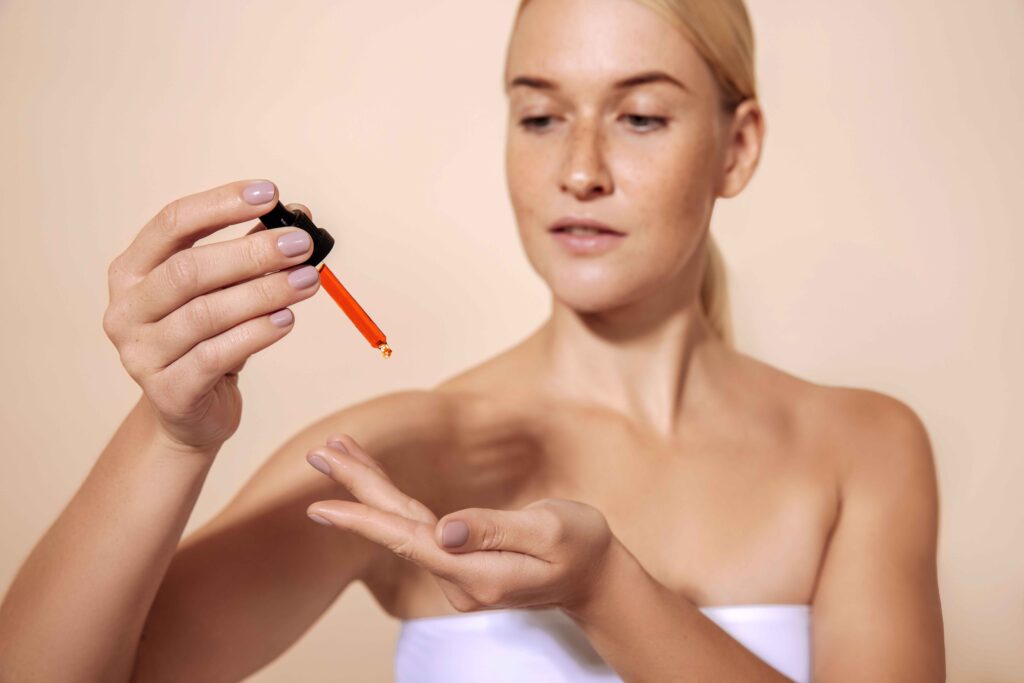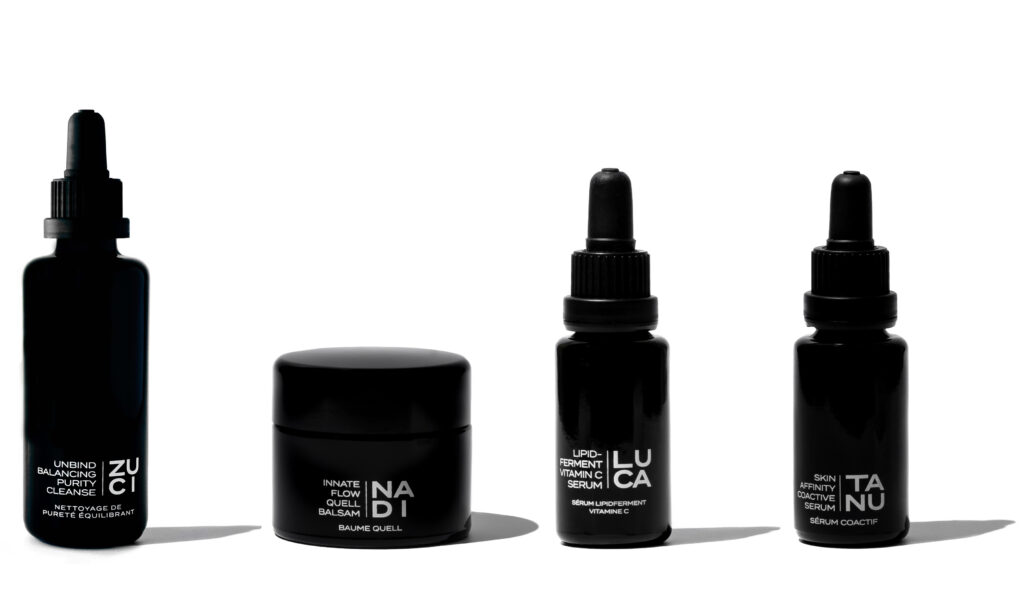In part 1 of this Blog article “What Causes Sensitive Skin?”. We learned what it means to have sensitive skin or if skin has become sensitised. In this article, we discover how to treat compromised or sensitive skin. Read part 1 here
The Stratum Corneum (SC) is the very outer layer of your skin. This is your body’s first defence against the environment, damage from the sun’s UV rays, micro-organisms, toxins, and foreign substances. A compromised skin barrier can no longer protect and maintain itself. Something has damaged the outer layer and the ability to protect, leaving it vulnerable to problems:
1) The skin can no longer hold onto moisture as well, causing dryness, flaking, itching, and redness
2) The skin can’t protect itself, making it more vulnerable to environmental toxins, UV rays, bacteria, allergens, and harsh ingredients.
It is critical for the health of your skin that the layer is intact. In Part One – What Causes Sensitive Skin? we looked at the many factors that affect the health of your skin. When your ‘barrier’ is compromised transepidermal water loss (TEWL) can occur. Therefore our skin can become more susceptible to irritants, allergens, and infections.
Your Barrier Function
- PERMEABILITY BARRIER. Consists of stratum corneum lipids, antimicrobial peptides, natural moisturising factor, cornified envelope and the corneocyte-lipid envelope. Maintenance of water gradient, calcium gradient, and acid mantle (acidic pH). Alongside the response of primary pro-inflammatory cytokines to impairment of the permeability barrier.
- ANTIMICROBIAL BARRIER. An acidic skin pH decreases skin colonisation by pathogenic bacteria and yeasts. Antibacterial activity of stratum corneum lipids (e.g., free fatty acids, sphingosine, others). Genetically encoded primary antimicrobial peptides (defensins, cathelicidins, dermcidins) synthesized in SC, present in sebum, and in sweat (dermcidin-derived). Multiple agents with antimicrobial activity as an alternative function (some chemokines, some neuropeptides, others).
- ANTIOXIDANT BARRIER. The network of enzymatic and nonenzymatic antioxidant systems to counter oxidative stress. Antioxidants present in the epidermis (stratum corneum, skin surface lipids) and dermis. Hydrophilic nonenzymatic antioxidants include ascorbic acid (vitamin C) and uric acid. A major lipid-soluble nonenzymatic antioxidant is alpha-tocopherol (vitamin E) Co-antioxidants (ascorbic acid, ubiquinol [coenzyme Q10]) allow tocopherol regeneration. Gradients in stratum corneum for ascorbic acid and tocopherol (lowest near-surface) Interceptive antioxidant enzymes (catalase, superoxide dismutases, glutathione peroxidases). Antioxidant repair enzymes (e.g., methionine sulfoxide reductase). The high concentration of alpha-tocopherol in sebum accounts for high levels in the facial sebaceous glands in the stratum corneum. Sebum serves as a physiological delivery pathway.
- IMMUNE RESPONSE BARRIER. Dendritic cells are involved in immune surveillance and antigen recognition. Toll-like receptors are involved in the recognition of microbial pathogens. Antimicrobial peptides and some of their enzymatic conversion products balance with the T regulatory cell system.
- PHOTO-PROTECTION BARRIER. The epidermal melanin barrier and the stratum corneum protein barrier Antioxidants protect against photo-oxidative stress. The optical reflective properties of the stratum corneum (outer layer of skin) provide photo-protection. The stratum corneum thickness is more important than epidermal thickness for protection against ultraviolet/solar radiation.
Too much of a good thing
Applying multiple skincare products with different active ingredients can increase the risk of skin irritation. More is not always better! This mindset can lead to a greater chance of interactions between the multiple ingredients within the different products. Take acids for example. Alpha and beta hydroxy acids can be very effective and gentle on the skin with good formulation. If you are using them too often this can irritate the skin. A sensation of burning or skin redness, causing inflammation – you now have a compromised skin barrier with way less function!
How to treat compromised or sensitive skin
KEEP IT SIMPLE
Is your skincare routine overcomplicated? With an already compromised skin barrier, this is akin to throwing fuel on the fire! Choose soothing, and nurturing skincare. Avoid foaming cleansers, which wash away our Natural Moisturising Factor (NMF). Ingredients such as astringents, like alcohol and witch hazel are also best avoided.
NATURAL MOISTURISING FACTOR NMF
These water-soluble compounds occur only in the outer layer of the skin. Its role is to ensure the skin remains hydrated despite the environmental factors it is exposed to.
EXFOLIATION
If they’re not gentle enough, they can bring up a lot of inflammation for sensitive skin. Remember your skin is already struggling and fighting off allergens. The last thing it now needs is exfoliating resulting in stripping away already depleted lipids. Enzymes such as Fermented Payaya can be beneficial for sensitive skin. Papain enzymes contain anti-inflammatory properties that can help soothe irritated or sensitive skin.
USE AN OIL CLEANSER OR BALM
For your face. Choose a body wash, soap or cleanser with a pH between 4.5 and 5.5 (normal pH of the skin.) Shampoo is a foaming product that contains a surfactant, in a shower it can run down onto your face.
OIL CLEANSER OR BALM – Clean without stripping away the skin’s microbiome or the skin’s protective Acid Mantle Barrier. Rinse your face with tepid water, not hot water as this will strip the skin. Showers and baths should not be overly hot for the same reason. Try not to itch already irritated skin, as this will damage the skin’s surface further.
RETINOL
Can be irritating for sensitive skin especially if you have rosacea, acne, or psoriasis. So much can depend on how a product has been formulated.
A PLANT-BASED ALTERNATIVE TO RETINOL
I developed TANU – Skin Affinity Coactive Serum because my skin cannot tolerate Retinol (of any strength/type). I don’t think long-term use is beneficial to your future skin health. TANU Serum is formatted with SYTENOL A® (Bakuchiol) with the same benefits as Retinol without skin sensitivity, and photo-sensitivity. It is gentle enough to use both AM and PM.
ACIDS
Active acids Hydroxy Acids are naturally occurring organic acids that promote exfoliation and, therefore, accelerate the turnover of skin cells. AHA (Alpha-Hydroxy Acid) and BHA (Beta-Hydroxy Acid) should be avoided as these remove the top layers of skin. The aim is to protect and build not strip away or remove your skin barrier when you have a sensitive or compromised skin barrier.
TANU – Skin Affinity Coactive Serum incorporates Fermented Willow Bark, which has long been used to soothe irritated skin. Offering anti-inflammatory and antibacterial properties, helping to clear pores and alleviate blemishes and irritation. High in tannins, phenolic acids, flavonoids, and numerous minerals, synergistically helping to soothe the skin and aid in cell regeneration.

PROTECT THE ACID MANTLE PH MATTERS
The Acid Mantle is an invisible viscous fluid known as a hydro-lipid film. The Acid Mantle maintains and protects the overall health of skin and hair and is slightly acidic — It comprises:
- Sebum is secreted by our sebaceous glands and this oily substance is our skin’s moisturiser.
- A salty watery mixture is secreted by our sweat glands
- Skins’ microbiome secretions.
These together form the Acid Mantle and have a pH level ranging from 4–6. pH is a measurement of acidity. A neutral pH is 7, anything above that creates an ALKALINE environment, and anything below creates an ACID environment.
USE A TONER
Avoid irritating astringents like Witch Hazel and alcohol [ethyl or denatured alcohols, which can damage the skin. Choose a water-based toner or hydrosol that is gentle and hydrating and will rebalance the pH of your skin.
HYDRATE
Hydrators are ingredients also known as humectants. Examples include glycerin, snow mushroom or hyaluronic acid. Humectants absorb water from the atmosphere or your skin and hold it in place on your skin.
MOISTURISE
Your skin with Emollients (oil and butter). Increase the rate of barrier repair as they contain lipids similar to those found naturally in our skin. Jojoba Oil is an excellent example of an emollient.
OCCLUSIVES
Help to form a barrier over the top of the skin increasing moisture levels and helping prevent epidermal water loss. Choosing a moisturiser with linoleic acid (omega 6 fatty acid) helps repair barrier function and is an effective moisturising agent. Omega 6 is an essential fatty acid that we can’t manufacture ourselves. Therefore we must obtain it through diet and/or topical application.
SPF PROTECTION
Sun exposure increases inflammation in the skin, (remember sitting by a window you are still exposed to UV light). Wear sunscreens – zinc-based ones offer good anti-inflammatory properties, also look also for antioxidants to ensure protection from other environmental stressors.
KNOW THE RIGHT INGREDIENTS
Get into the habit of reading the labels of any product that goes onto your skin. By reading the labels you can make sure you’re getting the building blocks you need to build the skin’s barrier.
ANTIOXIDANTS
Protecting against free radical damage can help maintain a strong skin barrier, so look for antioxidant ingredients in your products. Along with lipids you need good antioxidants and anti-inflammatories – vitamins A, C, D and E. LUCA Lipid Fermet Vitamin C Serum Formulated to boost your SPF/Sunscreen efficacy. A Luxurious, potent daily anti-pollution and blue-light serum to visibly revitalise and protect, boosted by a powerful skin-brightening complex.
FATTY ACIDS
Botanical seed oils contain bioactive lips called essential fatty acids (EFA). These play an important role in supporting skin barrier function along with additional skincare benefits of anti-inflammatory and anti-irritancy properties.
The goal is to the replenishment of the stratum corneum intercellular lipid membrane. How do we do this? By using formulations that contain lipids that assist in skin barrier repair:
- Ceramides
- Ceramide precursors
- Fatty acids,
You now know how to treat compromised or sensitive skin. So take time to consider what you are applying to your skin. Also, consider the number of different products you have included in your daily routine. Repair and build up your skin’s barrier with ‘Barrier repair agents’. NADI Innate Flow Quell Balsam – The ultimate calm balm. Helps to calm irritated and compromised skin, overnight strengthening and rebuilding the skin’s barrier. While rejuvenating, hydrating and moisturising resulting in super-soft skin.
YOU ARE WHAT YOU EAT AND DRINK
The healthier you are generally, the better your skin will be. Simple carbohydrates, like refined sugar, white bread, and soda, cause your insulin levels to spike. This leads to inflammation throughout the body, so it is wise to cut them from your diet. Omega-rich foods such as wild-caught cold-water fish, flaxseed, and walnuts contain essential fatty acids (EFA). These are required for the absorption of fat-soluble vitamins A, D, E, and K.
DE-STRESS – When you are stressed skin tends to break out more. This is due to the increase in the stress hormone cortisol, which signals glands to produce more oil. The resulting oily skin is more prone to acne and other skin issues. Stress aggravates psoriasis, rosacea, and eczema and can cause hives and rashes. At this point, we are even more stressed it is important to not let this get on top of you. Have to read our free guide “How to Manage Stressed Skin” Download Holistic Skincare Guide
CONCLUSION
Be very aware of what you are eating and drinking. Try to develop the habit of asking yourself whether this is helpful or harmful for your health and your skin. Be patient changes take time and remember to be kind to yourself. Always do a skin patch test before trying any new product. Apply a small amount on the inside of your arm/side of the neck to test for visible skin reactions. Do this every time you switch brands and/or products.
Until next time, be human, be kind, be you


REFERENCES:
- Namadar AC, Palit A. Sensitive skin: an overview. Indian J Dermatol Venereol Leprol. 2013;79(1):9–16.
http://www.ijdvl.com/article.asp?issn=0378-6323;year=2013;volume=79;issue=1;spage=9;epage=16;aulast=Inamadar - Draelos ZD. Sensitive skin: perceptions, evaluation, and treatment. Contact Dermat. 1997;8(2):67–78.
https://www.ncbi.nlm.nih.gov/pubmed/9153340 - Naylor EC, Watson RE, Sherratt MJ. Molecular aspects of skin ageing. Maturitas. 2011;69(3):249–256.
https://www.ncbi.nlm.nih.gov/pubmed/21612880 - Misery, L., Loser, K. and Ständer, S. (2016), Sensitive skin. J Eur Acad Dermatol Venereol, 30: 2–8. doi:10.1111/jdv.13532
https://www.ncbi.nlm.nih.gov/pubmed/26805416
Comments +